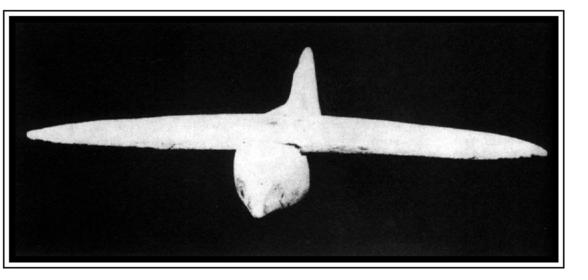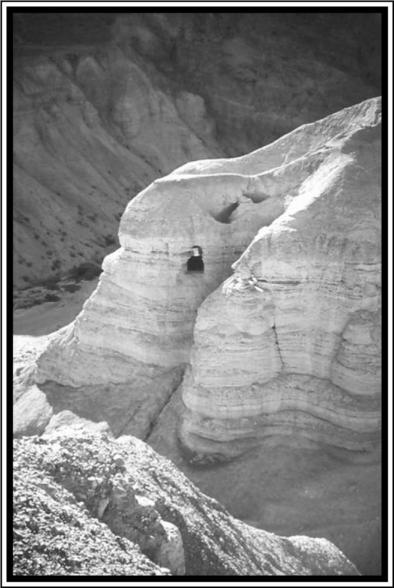Hidden History: Lost Civilizations, Secret Knowledge, and Ancient Mysteries (35 page)
Read Hidden History: Lost Civilizations, Secret Knowledge, and Ancient Mysteries Online
Authors: Brian Haughton
Tags: #Fringe Science, #Gnostic Dementia, #U.S.A., #Alternative History, #Amazon.com, #Retail, #Archaeology, #History

More gold examples were fashioned
by the Sinu culture of coastal Colombia, a gold-working community that
existed between about A.D. 300 and A.D.
1550. These objects were about 5 centimeters long and were worn as pendants on neck chains. In 1954, some
examples of the Sinu models were
among the collection of ancient gold
artifacts sent by the Colombian government on a United States tour; 15
years later a modern reproduction of
one of the artifacts was given to zoologist and author Ivan T. Sanderson to
examine. Apparently, his conclusion
was that the object was not characteristic of any known winged animal. The
front wings were delta-shaped and
straight edged, for example, not like
an animal or insect. Sanderson
thought that it appeared more mechanical than biological, and even went
as far as to suggest that it represented
a high-speed aircraft at least 1,000
years old. In fact, the airplane-like
appearance of the objects encouraged
Dr. Arthur Poyslee to conduct windtunnel experiments at the Aeronautical Institute of New York, where he
came to a positive conclusion about
the object's ability to fly. In August
1996, a reproduction of one of these
gold models, built at a scale of 16:1,
was flown successfully by three German engineers: Algund Eenboom, Peter Belting, and Conrad Liibbers.
From their research, they concluded
that the original artifact resembled a
modern space shuttle or the supersonic Concorde rather than an insect.
Most of these intriguing South
American pendants have four wings
(or two wings and a tail) and do not
look similar to any known insects or
birds. Granted, they are stylized models, but the resemblance to an airplane,
and even the space shuttle, is surprising. However, if we are to believe
that the objects are supposed to represent some kind of aerial vehicle that actually flew, there are one or two
problems with many of them. First, on
the majority of the models the wings
are depicted too far back from the
object's center of gravity to allow for
stable flight; second, the nose does not
resemble anything on an aircraft.
Amazingly little original research
into the origin of these artifacts has
been done by advocates of the ancient
airplane theory. Most of the Web articles about pre-Columbian airplanes
mention "South American" or "Central
American" models found in tombs, but
no exact provenance is given for most
of them, and usually no exact dates are
mentioned. Perhaps this is partly due
to the prolific looting of ancient tombs
in Colombia, and the subsequent appearance of their contents on the antiquities market in South America,
that still continues to this day. However, the vast majority of Internet sites
devoted to the subject of South American ancient aircraft merely reproduce
a 1996 article by Lumir G. Janku of the
Anomalies and Enigmas Website.
Without further research into their
exact origin and cultural context, the
labeling of these intriguing artifacts
as ancient airplane models seems illadvised, to say the least.
Another small plane-like model,
believed by Egyptologists to be that of
a hawk with outstretched wings,
comes from Saqqara in Egypt. It was
apparently first discovered in 1898 in
the tomb of Pa-di-Imen in north
Saqqara, which dates to the fourth or
third century B.C. The object is made
of sycamore wood, with a length of
14.2 centimeters, wingspan of 18.3
centimeters, and weight of about 39
grams. There are hieroglyphs on the
tail that read "The Gift of Amon." The
god Amon in ancient Egypt was usually associated with the wind. After its
discovery, the object was stored in the
Cairo Museum until 1969, when Khalil
Messiha, an Egyptian professor of
anatomy and student of ancient models, noticed its resemblance to a modern airplane, or glider. He also
perceived that whereas other bird
models in the Museum had legs and
painted feathers, this one did not.
Messiha was of the opinion that the
design exhibited many aerodynamic
qualities. After his brother, a flight
engineer, made a balsa wood model of
the object which flew successfully,
Dr. Messiha was convinced that the
Saqqara Bird represented an ancient
scale model of a glider.
However, Martin Gregorie of
Harlow, in Essex, who has designed,
built, and flown gliders for more than
30 years, disagrees. Experimenting
with the design he found that without
a tailplane (the fixed horizontal tail
surface of an airplane) which he believes the model never had, the model
was totally unstable. Even after he had
fitted a tailplane to the model, the results were unconvincing. Gregorie suggested that the model may have
functioned as a weather vane or perhaps a child's toy. Larry Orcutt, of the
Catchpenny Mysteries Website, believes the object could have been a
weather vane to indicate wind direction on a boat. He bases his idea on bird
figures on the mastheads of boats and
ships shown on reliefs from the
Temple of Khonsu at Karnak, dating
to the late New Kingdom (c. 12th century B.C.). Orcutt also notes that there
are in fact traces of paint on the beak
and tail, which indicates that it was once a richly painted model of a bird.
The black eyes on the object, actually
the ends of an obsidian bar which has
been fitted through the head, are not
shown in many of the photos circulating of the model, thus significantly increasing its resemblance to an
airplane. Consequently, while the
Saqqara Bird seems to possess one or
two aerodynamic qualities, the possibility that it is the sole surviving scale
model of an Egyptian aircraft seems
unlikely. Rather, the available evidence of well-crafted Egyptian game
boards and toys would point to the
object being a model of a bird, or perhaps a child's toy.

@ David Hatcher Childress
Wooden model, probably of a bird, from Saqqara, Egypt dated to the
fourth or third century B.C.
Probably the most controversial
evidence for ancient flight comes from
the puzzling carvings on a panel from
the 19th Dynasty Temple of Seti I, at
Abydos, Egypt. These incredible
glyphs appear to show a helicopter,
perhaps a tank, and what looks similar to either a space ship or a jet plane.
In fact, one of these glyphs has
achieved legendary status as "The
Abydos Temple Helicopter." So do
these amazing hieroglyphs show that
the Egyptians of the 13th century B.C.
possessed 21st century technology?
Unfortunately, some of the photos of
the glyphs doing the rounds on the
Internet have been digitally altered to
emphasize the aircraft-like features.
Nevertheless, there are still some untouched photos in existence showing
these extraordinary hieroglyphs of
apparently modern aerial vehicles.
However, Katherine GriffisGreenberg of the University of Alabama at Birmingham, as well as many
other archaeologists and Egyptologists,
maintain that the extraordinary carvings are palimpsests-newer writing
inscribed over old. The Egyptologists
theory is that, in this particular case,
plaster has been added over the old
inscription and a new inscription
made. The plaster subsequently fell
out due to time and weathering, leaving bits of the old and new glyphs overlapping and causing images that
resemble modern aircraft. It is certainly a fact that a considerable amount
of recarving of inscriptions took place
in ancient Egypt, as ruling pharaohs
attempted to claim the work of previous kings, or to destroy their reputation. It seems that in the case of the
Abydos Helicopter panel what has happened is that King Ramesses II, well known for appropriating the work of
his predecessors, has covered the
panel of his predecessor, King Seti I,
with his own inscription. More specifically, the hieroglyph text actually consists of part of the title of Ramesses
II, translated as "The one of the Two
Ladies, who suppresses the nine foreign countries." This overlies the royal
title of Seti I that was originally carved
into the stone.
Nevertheless, believers in the
Abydos Helicopter argue that overlying inscriptions resulting in such
striking images of modern aircraft
would be too much of a coincidence.
But there are other factors which
make ancient airplanes in Egypt improbable. One is the complete lack of
any flying machines whatsoever in the
entire ancient Egyptian corpus. There
should be more related inscriptions,
but there's nothing. In addition-and
this applies to all the ancient aircraft
theories-there is a complete absence
of evidence for the necessary support
technology required of a flight industry. If Egyptian and South American
cultures had developed and assembled
such things as helicopters and airplanes, they would have needed a huge
manufacturing industry for the vehicles themselves, not to mention provision for fuel production, mines to
obtain metal, and storage facilities.
Where is it all? If the ancients were
flying around in modern airplanes and
helicopters, surely there would be
more evidence than a collection of dubious models and a solitary panel of
hieroglyphs carved over a temple doorway. There is no denying that the idea
of human flight must certainly have
occurred to many ancient cultures, as
witnessed by the literature of India, for
example, and perhaps this was part of
the inspiration for the enigmatic South
American models. However, at present,
the physical evidence that they ever
achieved it is debatable at best.


Photograph by Grauesel (GNU Free Documentation License).
Caves at Qumran, in the area where the Dead Sea Scrolls were found.
The Dead Sea Scrolls are, without
doubt, the most significant and exciting manuscript find of the last 100
years. The cache of scrolls and scroll
fragments were discovered in 11 caves
in the area of Qumran, 13 miles east
of Jerusalem, close to the Dead Sea in
Israel. This extraordinary library of
Jewish documents dates from between
the third century B.c. and A.D. 68, and
consists of scrolls made from animal
skins (parchment), a few of papyrus,
and one extremely unusual example in
copper. The texts are written using a
carbon-based ink, and are written
mostly in Hebrew, with some in Aramaic (a Semitic language allegedly spoken by Jesus), and a small number in Greek. Research into these mysterious documents and their authors has
been ongoing since their initial discovery in the late 1940s and has thrown
some fascinating light, not only on the
Bible, but also on a shadowy brotherhood of men and women known as the
Essenes.
In 1947, Bedouin goat hearders
were searching for a stray goat among
the cliffs overlooking the Dead Sea
when they came upon a hitherto unexplored cave. Inside the cave, the
Bedouins discovered a number of ancient clay jars along the walls, which
were filled with manuscripts and
wrapped in linen. In all, seven clay jars
were recovered from the cave (known
as Cave 1) and thus began the nineyear-long investigation of the caves
around the northwest shore of the
Dead Sea. During the search for
scrolls, archaeologists often had to deal
with the problem of local Bedouins
plundering the caves, eager to make a
profit by selling the manuscripts to
Arab antiqities dealers in Bethlehem.
Eventually, however, the investigations produced approximately 800
documents from 11 different caves at
Qumran. A few of these caves, particularly Cave 4, appear to have functioned
as permanent libraries with built-in
shelves.